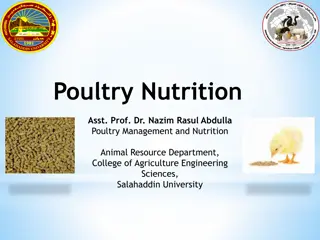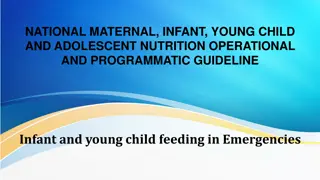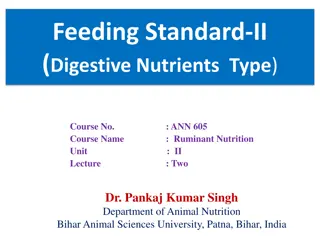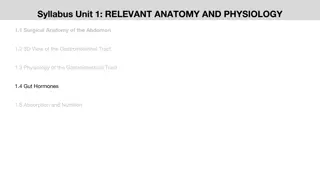Family Hub Volunteer Opportunities in Basildon - Get Involved Today
Access free health services, support your child's development, and build strong parent-child relationships at your local Family Hub in Basildon. Volunteer opportunities are available across various services. Contact Community Engagement Worker Debbie Hunt or Volunteer Coordinator Clare Chinery to jo
0 views • 7 slides
Feeding of Cattle and Buffalo
Explore the key concepts of ration formulation for feeding cattle and buffalo, focusing on balanced nutrition, ingredients, characteristics of a good ration, and best practices to ensure optimal health and productivity. Learn from Dr. Muneendra Kumar, Assistant Professor at the Department of Animal
0 views • 58 slides
Understanding Composite Fish Culture for Increased Productivity
Composite fish culture involves stocking different fish species with varying feeding habits in the same pond to optimize space and resources. This method allows for the utilization of all niches in the pond, leading to assured production and easy management. The article covers the species involved,
6 views • 16 slides
Guidance on Hospice Care and Feeding Tubes for Elderly Patients
Learn about the appropriateness of hospice care for a 74-year-old female with heart failure and the use of feeding tubes for an 89-year-old female with advanced Alzheimer's dementia. Understand important considerations for palliative care decisions.
4 views • 125 slides
Poultry Nutrition
Developments in poultry nutrition have led to increased productivity in the industry over the past 20 years. The focus is shifting towards life-cycle feeding programs for different bird classes rather than individual diets. Poultry diets consist of various feedstuffs providing essential nutrients fo
2 views • 33 slides
Understanding Feeds and Feeding Technology in Animal Production
Feed plays a crucial role in animal production systems, constituting a significant portion of production costs. Dr. Susan M. N. Muhamad, a dedicated lecturer, enlightens students on feedstuffs classification, nutritive characteristics, and practical feeding strategies. This course delves into the im
3 views • 23 slides
Alimentary Canal and Feeding Adaptations in Fishes by Dr. Sunitha A. Philip
The presentation discusses the alimentary canal and feeding adaptations in fishes, covering topics like the different regions of the gut, mouth types in fish, adaptation of teeth for specific diets, and the roles of the buccal cavity, pharynx, and gill rakers. It further explores how gill rakers var
0 views • 24 slides
Understanding ARFID: A Guide to Avoidant Restrictive Food Intake Disorder
Avoidant Restrictive Food Intake Disorder (ARFID) is a feeding and eating disorder characterized by significant weight loss, nutritional deficiency, and psychosocial impairment. Individuals may experience sensory sensitivity, lack of interest, or fear of aversive consequences. ARFID differs from pic
0 views • 18 slides
Supporting Optimal Nutrition Practices during Emergencies: IYCF-E and COVID-19 Technical Brief
In the context of the COVID-19 pandemic, it is crucial to protect, promote, and support appropriate Infant and Young Child Feeding (IYCF) practices. This includes maintaining respiratory hygiene during feeding, emphasizing handwashing, and promoting breastfeeding with necessary precautions. The IYCF
0 views • 11 slides
The Hague Convention of 1993 and Its Impact on Philippine Laws on Intercountry Adoptions and Child Welfare
The Hague Convention of 1993 plays a significant role in shaping Philippine laws regarding intercountry adoptions and child welfare. This convention emphasizes principles like the best interests of the child, subsidiarity principle, and prohibition of improper gain. It guides policies and legislatio
0 views • 10 slides
Comprehensive Guide on Dog Care and Management
Learn about housing, feeding, and dimensions of kennels for dogs, along with tips on appropriate feeding that plays a crucial role in keeping dogs healthy and fit. Dr. R.R. K. Sinha provides valuable insights on the care and management of dogs, emphasizing the importance of suitable housing, feeding
0 views • 42 slides
Essential Guidelines for Feeding Poultry for Optimal Production
Feeding poultry is a crucial aspect of poultry production, accounting for a significant portion of total expenses. Quality feed and proper feeding methods are key to maximizing efficiency. Understanding the nutritional needs of poultry, including water, carbohydrates, proteins, fats, vitamins, and m
1 views • 18 slides
Comprehensive Guide to Newborn Care and Parenting
This detailed guide covers essential topics related to newborn care and parenting, including choosing a healthcare provider, newborn supplies, baby's health at birth, circumcision, special care scenarios, feeding tips, and more. It provides insights into key aspects such as healthcare decisions, bab
1 views • 17 slides
Understanding Feeding Tubes: Types, Placement, and Care
Feeding tubes, such as gastrostomy and jejunostomy tubes, are used to provide nutrients when a patient is unable to eat normally. They come in various types and are placed through surgical or endoscopic procedures. Proper care, including site management, formula orders, and emergency protocols, is c
0 views • 33 slides
Understanding Feeding Standards and Their Objectives in Livestock Nutrition
Feeding standards provide tables indicating nutrient quantities necessary for livestock based on various physiological functions like growth, maintenance, lactation, and more. Objectives include guiding farmers in selecting balanced rations and classifying functions for individual animal needs. Glos
0 views • 13 slides
Understanding Fish Mouth Positions and Feeding Habits
The position of a fish's mouth reveals valuable information about its feeding habits, behavior, and lifestyle. Fish mouths can be categorized as superior (upward-facing), terminal (forward-facing), or inferior (downward-facing), each adapted for specific feeding strategies. Superior mouths are ideal
5 views • 10 slides
Infant and Young Child Feeding in Emergencies: Operational Guidelines
Infant and Young Child Feeding in Emergencies (IYCF-E) focuses on protecting and supporting safe feeding practices for infants and young children during all types of emergencies to reduce mortality and morbidity risks. Key actions include developing policies, training staff, coordinating operations,
4 views • 10 slides
Evolution of Feeding Standards for Ruminants: A Historical Perspective
The evolution of feeding standards for ruminants dates back to the 19th century, with pioneers like Grouven and Wolff introducing various criteria based on nutrient types and digestibility. Despite initial shortcomings, subsequent refinements by researchers like Professor Kuhn and Atwater have shape
0 views • 18 slides
Child Death Review Project in Western Cape
The Child Death Review Project presented by Prof. Shanaaz Mathews focuses on child murders in the Western Cape region, aiming to address the high child homicide rates and improve coordination between health, police, and social services to prevent further child deaths. By developing intersectoral res
0 views • 20 slides
Exploring Radio Tracer Techniques in Pharmacognosy and Phytochemistry II
In this unit, the focus is on metabolic pathways in higher plants and leveraging radioactive isotopes for biogenetic studies. Topics covered include steps in tracer techniques, selection of radioisotopes, preparation of labeled compounds, and insertion of radio-labeled metabolites in plant parts usi
0 views • 9 slides
Child Care Challenges in Kentucky: The Child Care Cliff
Explore the landscape of child care in Kentucky, revealing the challenges families face with the Child Care Cliff. Discover statistics on child care centers, family child care homes, and the average cost of child care in Kentucky. Understand the importance of the Child Care Assistance Program (CCAP)
0 views • 18 slides
Understanding Feeding Standards in Ruminant Nutrition
Feeding standards play a crucial role in determining the nutritional needs of animals for optimal health and productivity. They consider factors like productivity, product composition, and physiological conditions, guiding effective nutritional management. Despite their usefulness, feeding standards
0 views • 8 slides
Comprehensive Overview of IMNCI - Integrated Approach to Child Health
IMNCI is an integrated approach to child health focusing on common causes of child mortality like diarrhea, pneumonia, measles, malaria, and malnutrition. Developed to address child health in developing countries, IMNCI aims to reduce under-five mortality rates through preventive and curative measur
0 views • 25 slides
Sheep and Goat Clinic: Feeding, Exercising, and Show Preparation Tips
Topics covered in the Sheep and Goat Clinic include feeding strategies (last 90 days), the importance of balancing fat levels, exercising routines leading up to show day, and final points on feeding and fat management. The images provide valuable insights on feeding athletes, understanding fat level
0 views • 20 slides
Global Impact of Infant and Young Child Feeding (IYCF) Strategies
Global strategies like Infant and Young Child Feeding (IYCF) developed by WHO and UNICEF aim to address the high mortality rates among children under 5 due to malnutrition. The strategies emphasize the importance of appropriate feeding practices during pregnancy, lactation, and early childhood to co
0 views • 14 slides
Integrating Nutrition Assessment and Counselling: Complementary Feeding Practices
This training course focuses on educating facility-based health providers on complementary feeding practices, emphasizing the importance of introducing solid foods along with breastfeeding at 6 months. The session covers topics like nutrition gaps in breast milk, optimal feeding principles, and util
0 views • 48 slides
Feeding Practices for LBW Infants in LMICs
Improved survival rates of small babies highlight the importance of nutrition for LBW infants. Research into feeding practices in LMICs is crucial for promoting growth and development. Studies compare formula milk to human milk, exploring effects on growth, development, morbidity, and mortality. Evi
0 views • 21 slides
Importance of Feeding Infants with Breast Milk and Iron-Fortified Formula
Breast milk and iron-fortified infant formula are recommended for infants to meet their nutritional needs and support optimal development. Breast milk offers numerous health benefits, protecting infants from illnesses and reducing the risk of obesity. Iron-fortified formula is a suitable alternative
0 views • 23 slides
Challenges in Feeding Low Birth Weight Babies in Kenya
Addressing critical issues in feeding low birth weight babies in Kenya, including the lack of accurate birth weight measurements, preterm birth rates, and the risks associated with formula milk feeding. Strategies such as promoting expressed breastmilk and supporting mothers in neonatal units are di
2 views • 15 slides
Guidance for Complementary Feeding in Infants
After 6 months of age, breastfed infants may struggle to meet their nutrient needs from milk alone, necessitating the introduction of complementary foods. Implementing guiding principles can help ensure optimal nutrition and growth, including exclusive breastfeeding for the first 6 months, practicin
0 views • 18 slides
Assisting with Oral Feeding, Dysphagia Management, and Enteral Tube Feeding in Healthcare
This content covers essential aspects of assisting with oral feeding for individuals at risk for aspiration, managing dysphagia with specific recommendations and diet progression, and enteral tube feeding procedures and complications. It emphasizes safety, dignity, and independence in feeding practi
3 views • 12 slides
Assisting with Enteral Tube Feeding and Dysphagia Management
This content covers essential information on assisting with oral feeding for patients at risk of aspiration, managing dysphagia, diet progression, and enteral tube feeding procedures. It emphasizes safety, independence, and dignity in feeding practices. The content includes tips for preventing aspir
0 views • 12 slides
Tragic Cases of Child Abuse and Neglect in the UK
The cases of Victoria Climbié, Child BR, Child C, and Child H shed light on the devastating effects of child abuse and neglect in the UK. Victoria suffered 128 injuries before her death due to abuse and neglect. Child BR's death was a result of complications from a chronic health condition, highlig
0 views • 11 slides
Integrating Nutrition Assessment and Counseling for Child Feeding During Illness
This training session focuses on the importance of feeding children during illness and recovery, discussing feeding practices and options in difficult circumstances. Participants will learn strategies to encourage children to eat during challenging times, emphasizing the goal of continuing feeding r
0 views • 32 slides
Ration Formulation and Feeding Practices for Dairy Cattle and Buffaloes
This informative article discusses the importance of colostrum feeding, milk feeding to calves, and milk feeding schedules for dairy cattle and buffaloes during various phases. It emphasizes the significance of timely colostrum intake for immunity development and the proper feeding of whole milk or
0 views • 20 slides
New Hampshire's Labor Force and Child Care Industry Analysis
This analysis by Nicole Heller, PhD, Senior Policy Analyst at New Hampshire Fiscal Policy Institute, presents data on New Hampshire's labor force demographics and the challenges faced by the state's child care industry. It highlights the high cost of child care, lack of available slots, low wages fo
0 views • 20 slides
Understanding Re-feeding Syndrome: Metabolic Alterations and Pathophysiology
Re-feeding Syndrome (RS) is a critical condition characterized by severe metabolic changes during the repletion of underweight or malnourished individuals. The syndrome's hallmark is severe hypophosphatemia, leading to multisystem complications. This summary delves into the biochemical basis of RS,
0 views • 25 slides
Child Safe Standards Implementation in Sports & Organizations
Ensuring child safety in sports and organizations is crucial, as highlighted by concerning statistics on child abuse. The 10 Child Safe Standards framework aims to prevent, respond to, and report child abuse. Educating adults on potential harms to children and young people is essential in creating a
0 views • 17 slides
Understanding the Role of Gut Hormones in Regulating Feeding Behavior
The syllabus covers relevant anatomy and physiology related to the gastrointestinal tract, emphasizing the regulation of feeding processes. It discusses the role of gut hormones such as ghrelin, obestatin, cholecystokinin, pancreatic polypeptide (PP), and peptide YY (PYY) in controlling appetite, en
0 views • 7 slides
Understanding Nutrition in Animals: Types and Process
Nutrition in animals is vital for their survival, with various categories like herbivores, carnivores, and omnivores. Different modes of nutrition include filter feeding, deposit feeding, bulk feeding, fluid feeding, and suction feeding. The process of nutrition involves ingestion, digestion, absorp
0 views • 14 slides







































